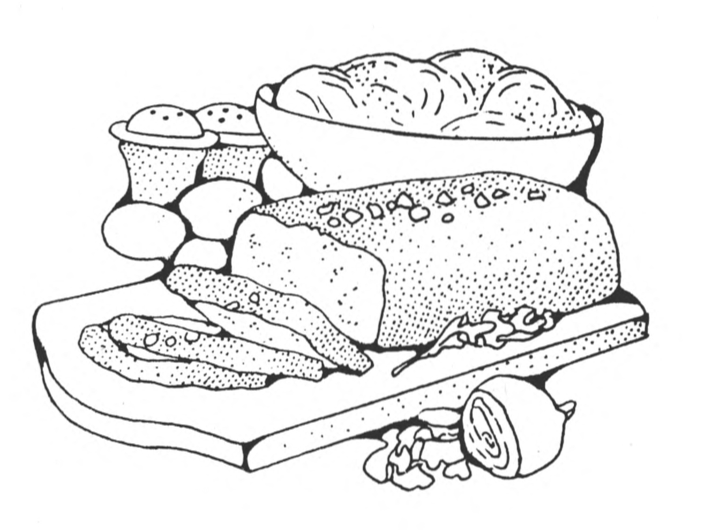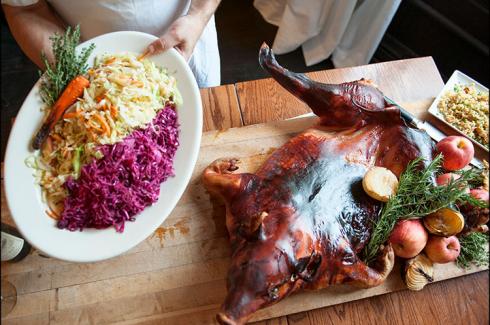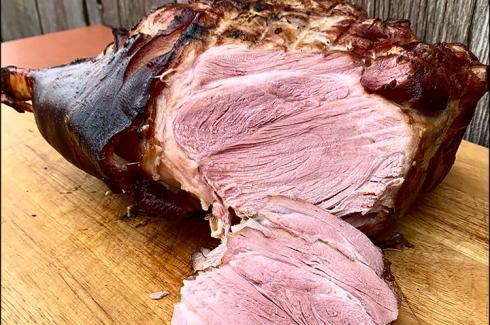“Poets have been mysteriously silent on the subject of cheese." — G.K. Chesterton
Upon reading this, a poet friend of mine, William Cole, sat down and composed a nine-stanza ode to cheese called “What a Friend We Have in Cheeses!” subtitled “Sing a Song of Liederkranz.” But neither he nor anyone else seems to have gotten around to penning a single line to meat loaf, a subject that sends perfectly rational people into raptures.
Not even the gifted Ogden Nash, who has written passionately about crazy, mixed-up “salmagundi salads” as well as his distaste for iceberg lettuce; “I cheerfully forgive my debtors, But I’ll never pardon iceberg lettuce, A pallid package of rigidity, A globe of frozen insipidity. . . .” It goes on to wonder why “a leafy head is as hard to get as unsliced bread.” Various poets have written couplets to cauliflower and verses to the globe-artichoke, but not one line can I find to the noble meat loaf. Not only that, one can’t even find meat loaf where it has every right to be expected: in cookbooks.
As long as the meat loaves are called “pate,” you will find them in many modern books, but then they will have lots of ground fat and liver and other un-American things. (1 wonder that Bush and Dukakis didn’t drag their mothers’ favorite meat loaves out of retirement while all that flag-waving was going on?) I suppose cookbook writers must think (erroneously) that every cook alive already has a meat loaf recipe perfectly suited to his or her own family’s taste. Not even in the 1896 edition of Fannie Farmer will you find a meat loaf, thus proving that meat loaf may not be the American standard I had always assumed it was.
My research indicates that hot meat loaf, the kind served with mash ed potatoes and a big splash of nostalgia, is an invention of the 20th century, and probably reached its zenith of popularity in the ’30s, when the Great Depression caused a lot of Americans to tighten up on the food budget. This lingering aura of being hard-times food must account for the abandonment of this once-favored food of Americans.
In an attempt to disperse the fumes of poverty that linger around one of my favorite dishes, I created a luxurious “Not Like Mom’s Meat Loaf,” which was included in a cookbook called “The Best of Cook's Magazine,” a compendium of 125 recipes the editors judged to be the best the magazine had ever published. That one was gussied up with expensive wild mushrooms. But recently, responding to a sheaf of meat loaf yearnings collected from various friends, I decided to make a real American roots-type meat loaf.
Meat Loaf Revisited
Nearly all food writers can be accused of having at least once written that if you can make a meat loaf, you can make a pate. This is true so far as it goes, but more things can go wrong with a meat loaf than with a pate. It will be served hot, so it has to hold together (a pate doesn’t have this problem), and it should be fluffy, not tough (which is caused by overmixing and also overcooking). Meat loaf as produced for large communal feedings is usually made in industrial-sized mixers which produce tough, leathery industrial-strength textures. A good meat loaf must be mixed lightly with human hands.
Serves eight to 10.
2 lbs. ground chuck beef
1 1/2 lbs. ground pork shoulder
1 1/2 lbs. lean ground veal
1/2 cup bourbon or cognac
2 tsp. coarse black pepper
2 Tbsp. juniper berries, ground
3 large cloves garlic, minced
1 cup onions, minced
2 Tbsp. salad oil
2 large eggs, beaten
1 cup soft white breadcrumbs
1/2 cup fresh parsley, minced
1 tsp. dried thyme leaves, crushed
3 tsp. salt
Mix the ground meats together and pour the spirits over them. Cover with plastic wrap and prepare the remaining ingredients, mixing, chopping, etc. A food processor is a big help; for instance in spinning a couple of trimmed slices of bread into instant crumbs. It’s also good for grinding up juniper berries (although a small electric Mini-chop is the best instrument for grinding spices).
Saute the garlic and onions in the oil until just transparent. Add these and all the remaining ingredients to the mixed meats, and blend with your hands. Try not to squeeze the meat, but rather lift it up and over with your fingers until it is thoroughly blended.
Preheat the oven to 350 degrees.
Shape the meat into a long oval loaf, patting it into shape in a heavy, long oval baking dish. Cover it with foil, sealing down the edges. Put this inside a roasting pan containing about an inch of water. Place the meat loaf in the center of the oven, and bake for one hour. Remove the wrappings, baste with the juices, and continue baking until an instant-read thermometer reads 170 degrees. This will normally take another half hour, but it could be longer.
When it is done, baste it again, then remove most of the accumulated fat with a bulb baster. Leave the meat loaf to rest in a warm place for 20 or 30 minutes before cutting in half-inch slices. This is important. Meat loaf cut the moment it comes out of the oven usually falls apart. You can cut the meat loaf right in the dish it is baked in, and the slices will be all the more juicy and flavorful for soaking up the pan juices. Note: In my research into the fate of the meat loaf (it almost doesn’t exist in cookbooks written in the last two decades), I came across this tip in an old treasure of mine, the Louis P. DeGouy Gold Cookbook: “Grated raw potatoes added to hamburger and meat loaf make the meat go farther, keep it moist, and prevent it from falling apart when cut.” I have not tested this — it’s advice you can take or leave alone.





